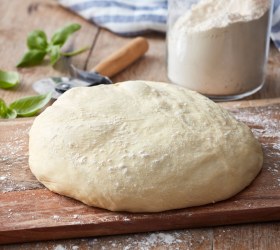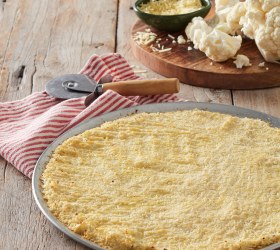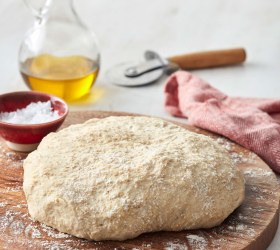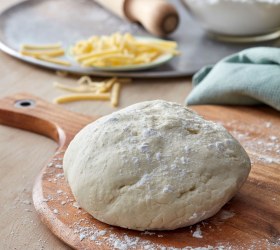How to stop your pizza base from going soggy
Pizza night is the best night. We aren’t ashamed to admit that a night in with homemade pizza in front of the TV is one of our favourite non-occasions. The only thing that can spoil it is a soggy pizza base. If you've ever asked "why is my pizza soggy," "why are my pizza toppings sliding around," or "how do I get a crispy pizza crust?" You're not alone. We’ve been there before, but once we started using these easy ways to get crispy, perfect pizza, we've never had to ask those questions again.
How to get a crispy pizza base
1. Use a pizza stone or perforated pizza pan
You know when you make a piece of crispy toast, pop it on a plate, and when you turn around it’s already soggy? The same thing happens with pizza. The steam from the base can't escape, so it condenses on your crispy surface and turns it wet and soggy.
Use a pizza stone or a pan with holes to get a crispy pizza crust. A pizza stone will keep your pizza hot and its porousness will absorb some condensation. A perforated pan has holes that will let the condensation escape, just remember to place it on a rack as it cools so the holes can do their work.
2. Pre-heat your pizza stone or pan before placing your pizza
This is essential for pizza stones as they will crack if put straight into a hot oven, but it also helps to bring your pizza to a high heat faster. High heat for quick cooking is one of the best ways to get a good crispy pizza crust, so pre-heating your pizza stone or pan will help a lot. Take care when placing your pizza on a hot surface.
3. Why you need to use the right cheese for pizza
Use the wrong type of cheese on a pizza and it can really affect your pizza base. Some cheeses separate, becoming oily and lumpy instead of melted and stretchy. This extra oil can make your pizza feel soggy, and toppings can start sliding around.
Too much fresh cheese with a high water content can also lead to sogginess. For example, fresh mozzarella that's stored in liquid should be used carefully, as it releases a lot of moisture in the oven.
The best cheese for pizza is a blend of cheeses for great texture, flavour and colour that won’t compromise your base. A good combination is a mozzarella for great stretch, cheddar for great flavour and parmesan for sharpness. Perfect Italiano Perfect Pizza cheese combines all three in the perfect ratio so you can enjoy a perfect pizza easily.
4. Don’t overload your pizza with toppings
As the old saying goes, less is more. As a common rule of thumb, try not to overload your pizza with more than four ingredients. Be particularly considerate of ‘wet’ ingredients that are likely to produce moisture. This includes ingredients such as fresh tomatoes, zucchini and fresh cheeses.
5. Why your oven temperature needs to be hot for pizza
Pizza requires a very high oven temperature to get a puffy, crispy crust, with golden cheese and cooked toppings. Be sure to let the oven pre-heat for sufficient time to reach its peak temperature. At least half an hour is a good amount of time. Once your oven is at its hottest, then you can add you pizza and you'll soon have the ideal crispy pizza crust.
6. How much sauce should you put on pizza?
A thin layer of sauce is all that's needed to add great flavour to your pizza. If you add too much sauce, toppings will start sliding around and the base will never quite reach crispy perfection. Three to four tablespoons is all you really need, you'll still be able to see the crust through the sauce.
The same applies when using a creamy sauce base or a ricotta pizza sauce base. Make sure to only use white sauce that has been thickened and a smooth ricotta that doesn’t have excess liquid in it.
7. How to reheat pizza in the microwave
Using the microwave to reheat pizza usually leads to floppy results, but you can get a crispy base on your reheated pizza by microwaving it on a piece of paper towel. The paper towel will soak up any steam underneath, keeping it crisp. You can also reduce the power level of your microwave to get a better slice.
Use these tips and you'll have crisp pizza! Find plenty of recipes for pizza dough and toppings to make your own perfect homemade pizza here on myfoodbook, see some of them below from our amazing recipe partners.
GET THE RECIPE: Basic Pizza Dough by Perfect Italiano
The first step to a crispy pizza base is having the right dough. Watch how to make great pizza dough step by step.
GET THE RECIPE: Cheesy Herb and Garlic Pizza by Perfect Italiano
Test out your new crispy-based pizza tips with this basic and delicious pizza.




























